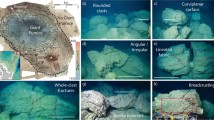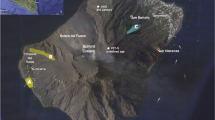Abstract
A well-defined pahoehoe lava type that is very common medially and distally in Hawaii is characterized by a high concentration and fairly uniform distribution of spherical or near-spherical vesicles. Measurements of vesicle sizes and concentrations have been made on ten of these spongy pahoehoe lava flow-units. The vesicles increase in size toward the middle, accompanied by a moderate increase in lava porosity. The close approach to bilateral symmetry on either side of the horizontal median plane and the common occurrence of a median gas blister shows that no significant upward movement of vesicles occurred, suggesting that the lava possessed a yield strength and was more or less static. Olivine phenocrysts when present are, however, concentrated in the lower half of the same flow units, showing that the lava previously lacked a significant yield strength. The vesicles are regarded as early, inherited from the vent, but the size characteristics of the vesicle population are a late-formed feature. Vesicles grew in static lava mostly by coalescence, and it is postulated that coalescence was promoted by the presence of abundant diktytaxitic voids which punctured the walls of contiguous vesicles. Zones in which the vesicle concentration is lower and the vesicles are larger and strongly deformed interrupt the symmetry of some spongy pahoehoe units, and gas blisters higher than the median plane occur in many examples. These zones are interpreted to result from late-stage shearing, and point to a mechanism by which vesicles may be eliminated from a lava.
Similar content being viewed by others
References
Dickinson WR, Vigrass LW (1965) Geology of the Suplee-Izee area, Crook, Grant and Harney Counties, Oregon. Oregon Dept Geol Mineral Res Bull 58:1–110
Godinot A (1988) Comment on “Pipe vesicles in Hawaiian basaltic lavas: their origin and potential as paleoslope indicators”. Geology 16:90
Lovering TS (1935) Theory of heat conduction applied to geological problems. Geol Soc Am Bull 46:69–94
McMillan K, Cross RW, Long PE (1987) Two-stage vesiculation in the Cohassett flow of the Grande Ronde Basalt, south central Washington. Geology 15:809–812
Philpotts AR, Lewis CL (1987) Pipe vesicles — an alternate model for their origin. Geology 15:971–974
Rowland SK, Walker GPL (1988) Mafic crystal distributions, viscosities, and lava structures of some Hawaiian lavas. Bull Volcanol 35:55–66
Shaw HR (1969) Rheology of basalt in the melting range.J Petrol 10:510–535
Shaw HR, Wright TL, Peck DL, Okamura R (1968) The viscosity of basaltic magma: an analysis of field measurements in Makaopuhi lava lake, Hawaii. Am J Sci 266:225–264
Sparks RSJ (1978) The dynamics of bubble formation and growth in magmas: a review and analysis. J Volcanol Geotherm Res 3:1–37
Sparks RSJ, Pinkerton H, Macdonald R (1977) The transport of xenoliths in magmas. Earth Planet Sci Lett 35:234–238
Swanson DA, Fabbi BP (1973) Loss of volatiles during fountaining and flowage of basaltic lava at Kilauea volcano, Hawaii. US Geol Surv J Res 1:649–658
Walker GPL (1987) Pipe vesicles in Hawaiian basaltic lavas: their origin and potential as paleoslope indicators. Geology 15:84–87
Author information
Authors and Affiliations
Rights and permissions
About this article
Cite this article
Walker, G.P.L. Spongy pahoehoe in Hawaii: A study of vesicle-distribution patterns in basalt and their significance. Bull Volcanol 51, 199–209 (1989). https://doi.org/10.1007/BF01067956
Received:
Accepted:
Issue Date:
DOI: https://doi.org/10.1007/BF01067956




